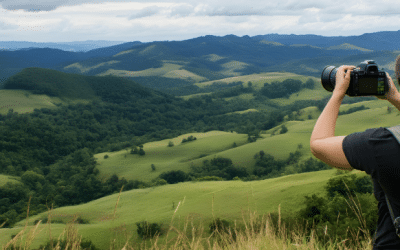Traveling to snowy destinations is not like any other type of tourism. Travelers looking for ski or snowboard destinations need precise, up-to-date, and easy-to-find information. If a travel website doesn’t meet these expectations, the likelihood of users leaving the page is high. And that’s something we don’t want!
In this article, we’ll explore the best strategies to optimize a travel website focused on snow and winter sports. From design and content to SEO strategies and technology, everything you need to attract and convert visitors into customers.
Key Factors for Improving a Travel Website Focused on Snow
Travel websites specializing in snow destinations require a clear structure, detailed information, and tools that make decision-making easier. Below, we explore the key aspects to enhance the user experience and increase bookings.
1. Clear and Mobile-Friendly Design
Think about your user: they plan their trip from their couch but also search for last-minute information on their mobile while on the road or already at the ski resort. It’s essential that the website looks and works perfectly on any device. A clean design, intuitive menus, visible buttons, and fast loading speeds make a difference. Also, ensure that the booking process is as simple as possible to avoid drop-offs.
2. Real-Time and Easily Accessible Information
One of the biggest mistakes travel websites make is not providing updated information. Skiers and snowboarders want to know the current conditions of the slopes, weather forecasts, and lift ticket availability before making a decision. Including real-time information, such as live webcams or weather data APIs, builds trust and can be a decisive factor in bookings. Additionally, having news sections or alerts about changing conditions can be a great advantage.
3. High-Quality Photos and Videos
Images play a key role in a traveler’s decision-making process. Showcasing high-quality photos of ski slopes, snowy landscapes, and available activities helps convey the excitement of the destination. Immersive videos, such as first-person ski runs or traveler testimonials, can be even more effective. If you can also include user-generated content like real photos and reviews, you’ll add an extra layer of authenticity that strengthens trust.
4. Simple and Efficient Booking Process
There’s nothing more frustrating than a complicated booking system. To prevent users from abandoning their reservations, the process should be clear and fast. Reduce unnecessary steps, display final prices with no hidden fees, and offer multiple payment methods. Also, ensure that the website loads quickly throughout all booking phases, as any delay can lead to lost sales.
SEO Strategies to Attract More Visitors
Ranking high in search results is crucial for gaining more visitors. Optimizing a snow travel website with effective SEO strategies will ensure greater visibility and qualified traffic.
1. Use Seasonal Keywords
Interest in snow destinations is seasonal, so the SEO strategy must adjust to different times of the year. Using keywords related to trending searches ensures better visibility on Google. Tools like Google Trends can help identify which terms are gaining traction, allowing you to optimize website content accordingly.
2. Create Useful Content for Travelers
A well-maintained blog can be a powerful tool for attracting organic traffic. Publishing practical guides on what to pack for a snow trip, safety tips on the slopes, or ski resort comparisons can make your site a go-to resource for travelers. Offering content in different formats, such as infographics or explainer videos, increases engagement.
3. Earn High-Quality Backlinks
Link building remains a key strategy in website ranking. Securing backlinks from relevant industry sources, such as travel blogs, ski resorts, or specialized media, not only improves SEO but also enhances the website’s credibility. Collaborations, guest posts, and social media mentions are effective tactics for gaining these links.

Technology to Improve User Experience
Leveraging technology to personalize the user experience and make trip planning easier is key to standing out from the competition.
1. Personalization and Smart Recommendations
Websites that offer personalized experiences achieve higher conversion rates. If you can tailor content to user interests and past searches, guiding them toward booking becomes easier. For example, if a visitor searches for “beginner ski trips,” you could show them resorts with easy slopes and beginner-friendly ski lessons.
2. Virtual Tours and Interactive Maps
Interactive maps with detailed information about ski trails, accommodations, and nearby services make trip planning much easier. Additionally, virtual tours of ski resorts allow users to explore the destination before making a decision, increasing confidence and excitement about the trip.
Digital Marketing Strategies to Drive More Bookings
A solid digital marketing plan can make the difference between a snow travel website that just gets visits and one that turns those visits into actual customers.
1. Social Media and Visual Content
Platforms like Instagram and TikTok are perfect for promoting snow destinations. Posting engaging content, such as videos of skiers enjoying the slopes, traveler testimonials, or exclusive promotions, can generate interaction and attract potential customers. Using specific hashtags and collaborating with travel influencers can expand your reach.
2. Email Marketing Campaigns
Email marketing remains one of the most effective strategies for customer retention and increasing bookings. Sending snow alerts, special discounts on lift passes, or loyalty rewards for repeat customers can encourage purchases. Additionally, segmenting campaigns based on user interests makes emails more relevant and effective.
3. Targeted Advertising
Investing in digital advertising can be a great strategy for attracting potential customers. Remarketing campaigns for users who visited the website but didn’t complete a booking, geotargeted ads for tourists nearby, or promotions aimed at users searching for “affordable ski trips” can significantly boost conversions.
Ready to Optimize Your Website?
Optimizing a travel website for snow destinations isn’t just about having an attractive design—it’s about providing useful information, a seamless booking process, and effective strategies to attract visitors. By implementing these improvements, you’ll increase traffic, enhance user experience, and, most importantly, secure more bookings.
Now, tell us, which of these strategies will you implement first? See you on the slopes!






